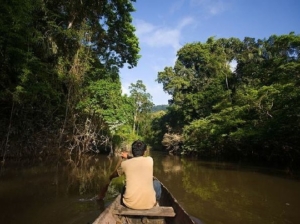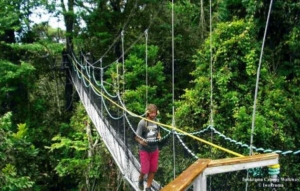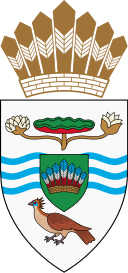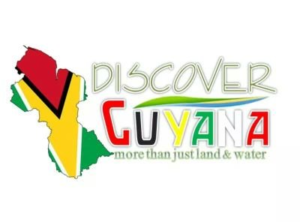About Guyana
 Guyana’s tropical rain forest, covering 86% of the land area, is among the most ecologically valuable and best preserved in the world. The environment is an issue of great importance for Guyana. Forestry development activities are expanding at a fast rate due to the country’s huge potential and the availability of a wide variety of precious woods which are in high demand in the overseas market. The government is committed to responsible and sustainable development of its forestry resources through astute management. Guyana is a member of the Treaty of Amazonian Cooperation which encourages the subscribers to carry out rational exploitation of the Region in coordination with the other seven South American countries. Moreover, Guyana took a lead role at the Earth Summit on Environment held in Rio de Janeiro, Brazil in June 1991, and endorsed the need to promote the process of sustainable development
Guyana’s tropical rain forest, covering 86% of the land area, is among the most ecologically valuable and best preserved in the world. The environment is an issue of great importance for Guyana. Forestry development activities are expanding at a fast rate due to the country’s huge potential and the availability of a wide variety of precious woods which are in high demand in the overseas market. The government is committed to responsible and sustainable development of its forestry resources through astute management. Guyana is a member of the Treaty of Amazonian Cooperation which encourages the subscribers to carry out rational exploitation of the Region in coordination with the other seven South American countries. Moreover, Guyana took a lead role at the Earth Summit on Environment held in Rio de Janeiro, Brazil in June 1991, and endorsed the need to promote the process of sustainable development
IWOKRAMA RAINFOREST PROGRAMME https://iwokrama.org/
 The Government in 1989 set aside an area of 360,000 hectares for the Iwokrama Rain forest Program, under the auspices of the Commonwealth to demonstrate the sustainable management of tropical forests and the conservation and utilization of biological diversity for the benefit of the international community. The Program for Sustainable Tropical Forestry (PSTF) includes:
The Government in 1989 set aside an area of 360,000 hectares for the Iwokrama Rain forest Program, under the auspices of the Commonwealth to demonstrate the sustainable management of tropical forests and the conservation and utilization of biological diversity for the benefit of the international community. The Program for Sustainable Tropical Forestry (PSTF) includes:
I A wilderness preserve to provide opportunities for research in biodiversity and ecosystems
ii The sustainable utilization of the resources to yield economic benefits for Guyana from wood and other products, mining, eco-tourism etc.
iii An International Center for Research and Training for the sustainable management of tropical forests.
WILDLIFE There are more than 6,100 species of plant, 1,000 species of tree, 450 types of bird, 400 species of fish, 120 species of amphibian and 180 species of mammal recorded to date.
The tapir is the largest land mammal; cats include the jaguar and ocelot. Monkeys and deer are the most abundant species and the caiman is the largest freshwater animal. The giant anaconda or water boa is also found in the rivers. The wealth of plant, animal, and micro-organism species include many so far unrecorded, whose properties are unknown to science. Guyana is also home to the large Harpy-Eagle.
TELECOMMUNICATIONS
Guyana’s country code is 592, followed by a seven-digit number for all areas of the country. Direct dialing is available from Guyana to any country in the world. The Guyana Telephone and Telegraph Company Office in Georgetown has public facilities for overseas calls. Local Internet Service providers (15%) offer walk-in Internet service. The country has 100% digital switching and a full range of value-added customer services such as voicemail. Local telephone cards are available.
TRANSPORTATION
Guyana’s international airport, named after the late President Dr. Cheddi Jagan, is located at Timehri, 25 miles/40 km south of Georgetown. There is a suburban aerodrome at Ogle which is currently being upgraded for internal flights and flights from the Caribbean. Large towns and many mining companies have airports or land strips.
There are excellent roads along the coast serving various points of the country, including the hinterlands. The completion of the Brazil/ Guyana road is expected to stimulate traffic/ trade between the two countries.
There is some 1,600 km of navigable river, 100 km of which are in areas of some economic activity. Passengers and cargo vessels go up the Demerara, Essequibo and Berbice Rivers, and also along the coast between the Rivers. Apart from the Demerara, which has a road bridge, the other major rivers have to be crossed by ferries.
Georgetown and New Amsterdam are the main ports.
REGIONS
Guyana is divided into three counties Demerara, Essequibo, and Berbice with ten Administrative Regions :
1 Barima – Waini
2 Pomeroon – Supenaam
3 Essequibo Islands-West Demerara
4 Demerara – Mahaica
5 Mahaica – Berbice
6 East Berbice – Corentyne
7 Cuyuni – Mazaruni
8 Potaro – Siparuni
9 Upper Takutu – Upper Essequibo
10 Upper Demerara – Berbice
11 Diaspora
Resources:
The coastal plain, along which the majority of the population lives is flat but the country is famous for its mountain ranges, lush forests, vast savannahs and above all the majestic Kaieteur Falls with an overall drop of 251 meters and a sheer drop of 226 meters. It is richly endowed with natural resources, extensive areas of fertile agricultural land, vast stretches of tropical hardwood forests most of which are still untouched, rich fishing and shrimping along the continental shelf, a wide variety of minerals (including gold, diamond and some semi-precious stones, bauxite and manganese) impressive resources for hydropower generation and potential for oil and gas production.
HERITAGE:
The original Guiana was inhabited by semi-nomadic Amerindian tribes who lived by hunting and fishing; notably Arawaks and Caribs. It was divided by European powers into Spanish Guiana (Venezuela), Portuguese Guiana (Brazil), French Guiana, Dutch Guiana (Suriname) and British Guiana (Guyana). Colonial competition for territory began with the Spanish sighting in 1499. Probably temporary Spanish or Portuguese settlements were followed by Dutch settlement, first unsuccessfully at Pomeroon, and then (in 1627) under the protection of the Dutch West India Company on the Berbice River. Despite yielding from time to time to British, French and Portuguese invasions, the Dutch kept control until 1814, when the colonies of Essequibo, Demerara, and Berbice were ceded to Britain. The Europeans imported African slaves to develop their plantations, first of tobacco and later sugar, and to labor on constructing the coastal drainage system and the elegant city of Georgetown. Some slaves escaped to the forest. Referred to as bush-blacks, these slaves eked out a living by panning for gold, hunting, and subsistence agriculture. The British administration merged the three colonies into British Guiana in 1831 but retained the Dutch administrative, legislative and legal system, whereby the country was directed by a governor, advised by councils of plantation owners. After the abolition of slavery, Indian and smaller numbers of Portuguese, Chinese and Japanese indentured laborers were brought in to work the estates. In 1928 a legislative council, with members appointed by the British government, was established, but members were elected after extensions of the franchise in 1943 and 1945. The country was by this period among the most advanced of the British colonial territories in the region and became the headquarters of several regional educational and political institutions. CARICOM headquarters is located in Georgetown. In 1953, a constitution with a bicameral legislature and ministerial system, based on elections under universal adult suffrage, was introduced. There was a general election, won by the People’s Progressive Party (PPP), led by Dr. Cheddi Jagan. Shortly after the 1953 elections, the UK suspended the constitution, decided to mark time in the advance towards self-government, and administered the country with a government composed largely of nominated members. When, in 1957, the UK did introduce elected members, the legislature voted for the more representative government. The UK called a constitutional conference which was held in 1960 and provided for a new constitution with full internal self-government. In the elections held in August 1961 under this constitution, the PPP again gained the majority. The UK held further constitutional conferences in 1962 and 1963, to settle terms for independence. The political parties failed to reach a consensus. The UK then selected a form of proportional representation that was aimed at preventing the People’s Progressive Party (PPP) from forming the government. (It was also argued that, at this period of the ‘Cuba crisis’ with near-war between the US and USSR, the UK was under pressure to avoid allowing a Socialist government to come to power in Guyana). Despite renewed disturbances, elections were held under the PR system and brought to power a coalition of the People’s National Congress led by Forbes Burnham and The United Force (TUF). The new government finalized independence arrangements at a further constitutional conference, which was boycotted by the PPP. Guyana gained independence and joined the Commonwealth in May 1966, and became a Republic four years later.
CONSTITUTION:
Guyana is a Republic, divided into ten (10) administrative regions, with an Executive President and parliamentary legislature. The 1980 Constitution, amended in 2001, provides for an executive presidency and a unicameral legislature – the National Assembly, with 65 members directly elected by proportional representation: 40 at a national level and 25 at a regional level. The normal life of a parliament is five years. The President appoints the Prime Minister and members of the Cabinet (which may include those from outside the Assembly), who are responsible to Parliament. The President is the leader of the largest party in the Assembly.
SOCIETY:
POPULATION:
750,204 (July 2020 est.), Most of the population live along the coast. There are pockets of communities in the inland areas. Guyana is a multiracial, multicultural and multireligious society. The country is composed several major race groups – 39.83% East Indians; 29.25% Africans; 10.51% Amerindians; The mixed population mainly consists of Chinese and Portuguese of 19.88%; 0.5% of other backgrounds.
RELIGION:
Christians 50%, Hindus 25%, Muslim 7%.
LANGUAGE:
English is the official language, An English-based Creole is widely used also known as Guyanese Creole, Chinese, Hindi, Amerindian languages include Macushi, Akawaio and Wai-Wai; and Arawakan languages such as Arawak (or Lokono) and Wapishana.
MEDIA:
The state-owned Guyana Chronicle, privately-owned Stabroek News, Kaieteur News and Guyana Times are dailies. The mirror is published twice a week, and the Catholic Standard weekly. There are a number of Television and Radio Stations.
EDUCATION:
Public spending on education was budgeted at 9.11% or G$11.6 billion of GDP in 2014. There are six years of primary education and five years of secondary. The primary net enrollment ratio is 97.5%. The pupil-teacher ratio for primary is 25.1% and for secondary 17.1%. The school year commences in September. Vocational schools include Georgetown Technical Institute, New Amsterdam Technical Institute, Carnegie School of Home Economics, and the Guyana Industrial Training Center. Tertiary establishments include the Cyril Potter College of Education (for teacher training), Guyana School of Agriculture, Commonwealth Youth Program Caribbean Center (which trains youth workers), and the University of Guyana in Georgetown has law and medical schools with a Campus in Corentyne.
HEALTH:
Public spending on health was budgeted at G$8.844 bn in 2014. The Public Hospital at Georgetown is the national referral hospital; there are 30 hospitals and 170 health centers, with both public and private care available, the formerly free. 94% of the population has access to an improved drinking water source and 95% to adequate sanitation facilities.
OFFICIAL VACATIONS IN GUYANA:
1- New Year’s Day: 1st January.
2- Republic Day/Mashramani: 23rd February.
3- Good Friday.
4- Easter Monday.
5- Labor Day: 01st May.
6- Arrival Day: 05th May.
7- Independence Day: 26th May.
8- Caricom Day: First Monday in July.
9- Freedom Day: 01st August.
10- Christmas Day: 25th December.
11- Boxing Day: 26th December.
Public holidays that follow the lunar calendar thus varying the date of the occasion:
1-Hindu Holiday – Phagwah – Spring Festival (usually March).
2- Hindu Deepavali Holiday – the Festival of Lights (in November).
3- Muslim Holiday – Eid ul Fitr (end of Ramadan).
4- Muslim Holiday -Eid ul Azah – Feast of the Sacrifice.
5- Muslim Holiday -Youman Nabi (Prophet Muhammad).
Exxon Ships First Oil From New Mega-Discoveries In Guyana
Guyana Embassy in US signs MoU with Diaspora body to enhance cooperation
US Scholar aims to transform UG’s engineering programmes
https://www.inewsguyana.com/us-scholar-aims-to-transform-ugs-engineering-programmes/
Goldman Sachs projects oil at $65 per barrel third quarter 2021
How Pumpkin Is Eaten Around The World
List of Countries
- China
- Armenia
- Guyana
- South Korea
- Russia
- India
- Thailand
- South Africa
- Japan
- Mexico
- Brazil
- Egypt


